Navigation
Scientists Mount a “Sting Operation” in Thailand to Tackle a Devastating Pest Outbreak
In the start of a carefully crafted emergency campaign to thwart a pest outbreak that is wreaking havoc on Thailand's vital cassava production, agricultural researchers will release a quarter of a million parasitic wasps (Anagyrus lopezi) in the northeastern part of the country.
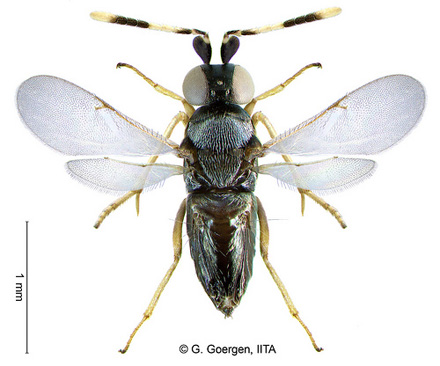 |
| The Anagyrus Lopezi wasp - a tiny but highly effective cassava mealybug parasitoid native to South America. The wasp is a tiny, very specific parasitoid of the cassava mealybug. Assessments were conducted in Africa, prior to the successful large-scale release of the wasp tackle cassava mealybug. These found no impact on other insects. Now, 25 years after mass deployment across a large part of the continent, there have been no major problems resulting from the use of the wasp, and it continues to be very effective against the cassava mealybug. Measuring less than 2 millimeters in length, the A. lopezi wasp has already shown itself to be a formidable natural enemy of the cassava mealybug in South America and sub-Saharan Africa. Even when infestations are low, female wasps are able to detect and home-in on their prey, injecting their eggs into the mealybugs. Photograph by Georg Goergen (IITA). |
In the start of a carefully crafted emergency campaign to thwart a pest outbreak that is wreaking havoc on Thailand's vital cassava production, agricultural researchers will release a quarter of a million parasitic wasps (Anagyrus lopezi) in the northeastern part of the country.
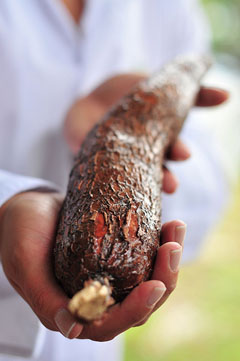 |
| A healthy cassava root. Photograph by Neil Palmer (CIAT) |
Thailand’s cassava industry alone accounts for more than 60 percent of global exports of this tropical root crop, which is critical for food security and economic growth in many developing countries. About 5 million growers across Southeast Asia supply cassava to domestic and foreign processing industries, which convert the roots to animal feed and biofuels and also extract starch from them for use in a wide variety of food and other products.
Thailand’s Department of Agriculture officially started the release of Anagyrus lopezi as a form of biological control in the country’s northeastern province of Khon Kaen on Saturday 17 July, 2010, following two small scale releases to evaluate environmental impact.
“Cassava is an important crop for small-scale farmers in our country, so there’s no time to lose in applying the fastest, most reliable solution available, said Amporn Winotai, who is a senior entomologist for Thailand’s Department of Agriculture.
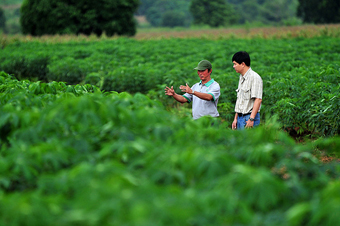 |
| Checking cassava plantations for signs of pests and diseases, near Khorat, eastern Thailand. Photograph by Neil Palmer (CIAT) |
“Cassava is a crucial crop in Thailand, generating more than US$1 billion of income for farmers each year, and more again to industry,” said Tin Maung Aye, a cassava agronomist with the International Center for Tropical Agriculture (CIAT). “Reductions of that magnitude translate into hundreds of millions of dollars in economic losses, especially if the pest is allowed to spread further.”
The pest is the cassava mealybug (Phenacoccus manihoti). Originally from South America, it feeds only on cassava, sucking sap from the plants and causing them to shrivel. Also a South American native, cassava was carried by Portuguese traders to Africa and Asia, where it thrived in the absence of the insect pests that inhabit its home territory.
But eventually, the mealybug and other insect pests caught up with cassava, devastating crops first in sub-Saharan Africa and now in Southeast Asia. The spread of cassava mealybug to about 200,000 hectares has been confirmed in eastern and northeastern Thailand, where the pest is causing yield losses as high as 50 percent.
Since the country’s cassava industry generates more than US$1.5 billion of income each year—and the overall Thai cassava industry is worth US$ 3bn—reductions of that magnitude could translate into hundreds of millions of dollars in economic losses, especially if the pest is allowed to spread further.
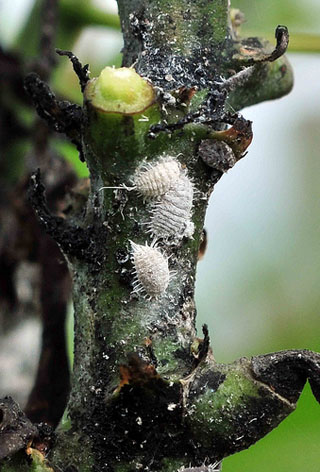 |
| Mealybugs on cassava crops in northeastern Thailand. Please credit accordingly. Tests were carried out to ensure that the wasp would control the mealybug and not become a predator or parasite of other insects. Photograph by Neil Palmer (CIAT). |
The pest is the cassava mealybug (Phenacoccus manihoti). Originally from South America, it feeds only on cassava, sucking sap from the plants and causing them to shrivel. Also a South American native, cassava was carried by Portuguese traders to Africa and Asia, where it thrived in the absence of the insect pests that inhabit its home territory.
But eventually, the mealybug and other insect pests caught up with cassava, devastating crops first in sub-Saharan Africa and now in Southeast Asia. The spread of cassava mealybug to about 200,000 hectares has been confirmed in eastern and northeastern Thailand, where the pest is causing yield losses as high as 50 percent.
Since the country’s cassava industry generates more than US$1.5 billion of income each year—and the overall Thai cassava industry is worth US$ 3bn—reductions of that magnitude could translate into hundreds of millions of dollars in economic losses, especially if the pest is allowed to spread further.
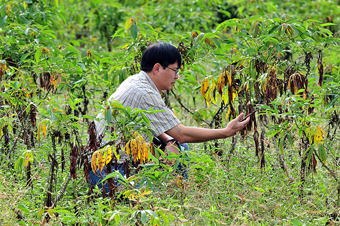 |
| CIAT cassava specialist Dr. Tin Maung Aye studies cassava crops in northeastern Thailand, which have been affected by a combination of pest and disease outbreaks. Cassava harvesting near Khorat, Thailand. Photograph by Neil Palmer (CIAT) |
In mounting the emergency campaign, Thai scientists consulted with two organizations – the International Institute of Tropical Agriculture (IITA) branch in Benin and the Colombia-based CIAT. Both centers are supported by the Consultative Group on International Agricultural Research (CGIAR).
IITA, CIAT and various partner organizations curbed mealybug attacks on Africa’s cassava crop during the 1980s through a highly successful biocontrol campaign, which staved off a major food security catastrophe, according to IITA entomologist Georg Goergen. Goergen hand-carried a colony of the 500 wasps from Benin to Bangkok last year to start the testing and mass rearing.
The Thai Department of Agriculture’s Winotai said, “Identifying the cassava mealybug species in Thailand was at first complicated by its resemblance to another closely related mealybug species, P. madeirensis, which is probably also from South America but poses no threat to cassava. “
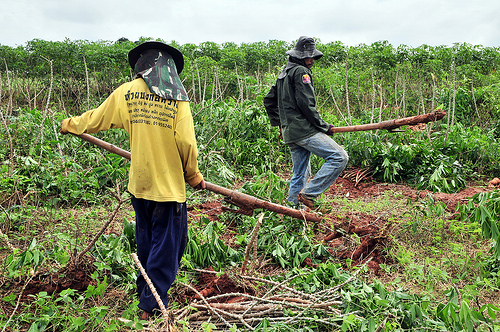 |
| Cassava harvesting near Khorat, Thailand. Please credit accordingly. Photograph by Neil Palmer (CIAT) |
Within a year after confirming the presence of the cassava mealybug, P. manihoti, the Thai Department of Agriculture had arranged for importation of the pest’s most effective natural enemy, following strict quarantine procedures, and then carried out controlled testing and mass multiplication ready for a possible release.
Early on, researchers discarded the option of containing the mealybug in Thailand with pesticides. “Applying chemicals on such a large scale would be environmental vandalism,” said Tony Bellotti, a CIAT entomologist, who has spent 35 years investigating cassava pests. “Sending in the wasps is a proven way to kill the cassava mealybugs quickly and effectively. Think of them as a kind of eco-friendly SWAT team.”
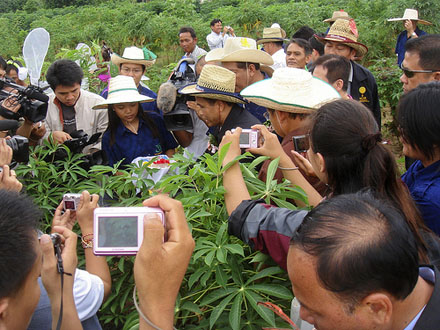 |
| Scientists and local media join about 400 farmers gathered to witness the release of the tiny parasitic wasp, Anagyrus Lopezi, at a ceremony organised and hosted by the Thai Department of Agriculture in the country's northeastern Khon Kaen province (17 July 2010). By releasing the wasps in their own cassava fields, the farmers will contribute to the planned dissemination of A. lopezi to all the country's cassava fields by the end of the year. "The ceremony was held at the DoA’s Khon Kaen Field Crops Research Center in the heart of NE Thailand, where some of Thailand’s more than 400,000 cassava farmers are located," said Rod Lefroy of CIAT. Photograph by Rod Lefroy (CIAT). |
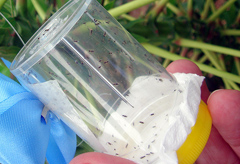 |
| Thai cassava farmers came prepared for the official release of a swarm of parasitic wasps, which it is hoped will help the country tackle a devastating cassava mealybug epidemic. Some of them brought containers to collect their own samples of the tiny Anagyrus lopezi wasps. Photograph by Roy Lefroy (CIAT) |
The pest population is then gradually reduced, as the wasp larvae grow and as adult females feed on the host insect. The wasps pose no threat to humans, animals, or other insects.
The wasp proved so effective in sub-Saharan Africa that Hans Herren, the scientist who led the biocontrol effort there, was awarded the World Food Prize in 1995. The collaborative effort also earned IITA and CIAT the CGIAR’s 1990 King Baudouin Award, which recognizes outstanding contributions to developing country agriculture.
The economic benefits resulting from biocontrol of the cassava mealybug in Africa exceeded the cost of the research by a factor of at least 200.
CIAT scientists are investigating reports that that the cassava mealybug has already spread to Cambodia, Burma, Laos and Vietnam. Bellotti expects that it will soon reach other parts of Southeast Asia as well, including southern China, and eventually to Indonesia and the Philippines.
“It’s going to be an international game of cat-and-mouse,” he said. “As the cassava mealybug finds its way to new countries and regions, we can send in the wasps.” In the long term, Bellotti explained, scientists will also need to develop cassava crops with genetic resistance to mealybugs as part of integrated pest management strategies.
To be most effective, biocontrol must be combined with more resilient cassava varieties and better crop management.
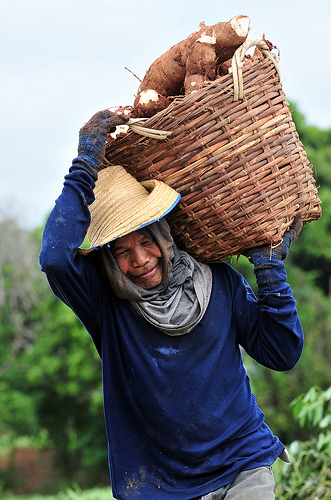 |
| Cassava harvesting near Khorat, Thailand. Photograph by Neil Palmer (CIAT) |
"Cassava production in Southeast Asia has enjoyed an extended honeymoon, relatively free of major pest and disease outbreaks,” Bellotti continued. “But now it’s over. And the mealybug isn’t the only cassava pest out there. Mites and whiteflies, for example, are also extremely damaging and there are some worrying diseases as well.”
“Thailand’s rapid response to stop the cassava mealybug plague shows international agricultural research at its best,” said Ruben Echeverria, director general of CIAT. “This is why it’s so important for developing countries to have strong research programs working closely with the international centers like CIAT and IITA.”
***
This news is from the International Center for Tropical Agriculture (CIAT).
The International Center for Tropical Agriculture (CIAT) is a not-for profit organization that conducts socially and environmentally progressive research aimed at reducing hunger and poverty and preserving natural resources in developing countries. www.ciat.cgiar.org
The International Institute of Tropical Agriculture (IITA) is a nonprofit research-for-development organization that works with partners in Africa and beyond to tackle hunger and poverty by reducing producer and consumer risks, enhancing crop quality and productivity, and generating wealth from agriculture. www.iita.org
The Consultative Group on International Agricultural Research (CGIAR), established in 1971, is a strategic partnership of countries, international and regional organizations and private foundations supporting the work of an alliance of 15 international Centers. In collaboration with national agricultural research systems, civil society and the private sector, the CGIAR fosters sustainable agricultural growth through high-quality science aimed at benefiting the poor through stronger food security, better human nutrition and health, higher incomes and improved management of natural resources. www.cgiar.org
Search
Latest articles
Agriculture
- World Water Week: Healthy ecosystems essential to human health: from coronavirus to malnutrition Online session Wednesday 24 August 17:00-18:20
- World Water Week: Healthy ecosystems essential to human health: from coronavirus to malnutrition Online session Wednesday 24 August 17:00-18:20
Air Pollution
- "Water and Sanitation-Related Diseases and the Changing Environment: Challenges, Interventions, and Preventive Measures" Volume 2 Is Now Available
- Global Innovation Exchange Co-Created by Horizon International, USAID, Bill and Melinda Gates Foundation and Others
Biodiversity
- It is time for international mobilization against climate change
- World Water Week: Healthy ecosystems essential to human health: from coronavirus to malnutrition Online session Wednesday 24 August 17:00-18:20
Desertification
- World Water Week: Healthy ecosystems essential to human health: from coronavirus to malnutrition Online session Wednesday 24 August 17:00-18:20
- UN Food Systems Summit Receives Over 1,200 Ideas to Help Meet Sustainable Development Goals
Endangered Species
- Mangrove Action Project Collaborates to Restore and Preserve Mangrove Ecosystems
- Coral Research in Palau offers a “Glimmer of Hope”
Energy
- Global Innovation Exchange Co-Created by Horizon International, USAID, Bill and Melinda Gates Foundation and Others
- Wildlife Preservation in Southeast Nova Scotia
Exhibits
- Global Innovation Exchange Co-Created by Horizon International, USAID, Bill and Melinda Gates Foundation and Others
- Coral Reefs
Forests
- NASA Satellites Reveal Major Shifts in Global Freshwater Updated June 2020
- Global Innovation Exchange Co-Created by Horizon International, USAID, Bill and Melinda Gates Foundation and Others
Global Climate Change
- It is time for international mobilization against climate change
- It is time for international mobilization against climate change
Global Health
- World Water Week: Healthy ecosystems essential to human health: from coronavirus to malnutrition Online session Wednesday 24 August 17:00-18:20
- More than 400 schoolgirls, family and teachers rescued from Afghanistan by small coalition
Industry
- "Water and Sanitation-Related Diseases and the Changing Environment: Challenges, Interventions, and Preventive Measures" Volume 2 Is Now Available
- Global Innovation Exchange Co-Created by Horizon International, USAID, Bill and Melinda Gates Foundation and Others
Natural Disaster Relief
- STOP ATTACKS ON HEALTH CARE IN UKRAINE
- Global Innovation Exchange Co-Created by Horizon International, USAID, Bill and Melinda Gates Foundation and Others
News and Special Reports
- World Water Week: Healthy ecosystems essential to human health: from coronavirus to malnutrition Online session Wednesday 24 August 17:00-18:20
- STOP ATTACKS ON HEALTH CARE IN UKRAINE
Oceans, Coral Reefs
- World Water Week: Healthy ecosystems essential to human health: from coronavirus to malnutrition Online session Wednesday 24 August 17:00-18:20
- Mangrove Action Project Collaborates to Restore and Preserve Mangrove Ecosystems
Pollution
- Zakaria Ouedraogo of Burkina Faso Produces Film “Nzoue Fiyen: Water Not Drinkable”
- "Water and Sanitation-Related Diseases and the Changing Environment: Challenges, Interventions, and Preventive Measures" Volume 2 Is Now Available
Population
- "Water and Sanitation-Related Diseases and the Changing Environment: Challenges, Interventions, and Preventive Measures" Volume 2 Is Now Available
- "Water and Sanitation-Related Diseases and the Changing Environment: Challenges, Interventions, and Preventive Measures" Volume 2 Is Now Available
Public Health
- Honouring the visionary behind India’s sanitation revolution
- Honouring the visionary behind India’s sanitation revolution
Rivers
- World Water Week: Healthy ecosystems essential to human health: from coronavirus to malnutrition Online session Wednesday 24 August 17:00-18:20
- Mangrove Action Project Collaborates to Restore and Preserve Mangrove Ecosystems
Sanitation
- Honouring the visionary behind India’s sanitation revolution
- Honouring the visionary behind India’s sanitation revolution
Toxic Chemicals
- "Water and Sanitation-Related Diseases and the Changing Environment: Challenges, Interventions, and Preventive Measures" Volume 2 Is Now Available
- Actions to Prevent Polluted Drinking Water in the United States
Transportation
- "Water and Sanitation-Related Diseases and the Changing Environment: Challenges, Interventions, and Preventive Measures" Volume 2 Is Now Available
- Urbanization Provides Opportunities for Transition to a Green Economy, Says New Report
Waste Management
- Honouring the visionary behind India’s sanitation revolution
- Honouring the visionary behind India’s sanitation revolution
Water
- Honouring the visionary behind India’s sanitation revolution
- Honouring the visionary behind India’s sanitation revolution
Water and Sanitation
- Honouring the visionary behind India’s sanitation revolution
- Honouring the visionary behind India’s sanitation revolution

